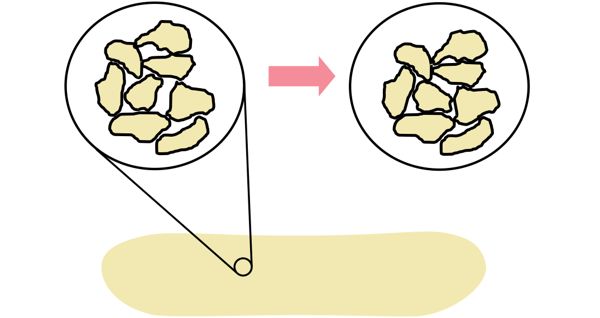Soil is a dynamic material that experiences various stresses and loads throughout its history. These loads can come from natural sources, such as deposition and glaciers, or from human activities, such as construction activities.

Also these loads get removed from the soil by natural and human activities such erosion, surface drying, mining etc.

Over time, these varying loads change the soil’s structure and behaviour, which can have important implications for engineering projects.

In geotechnical engineering, a soil that has never been under any significant pressure before is called a “Virgin Soil”. Such soils are very compressible, which means they will deform and settle a considerable amount when the load is applied. This is because their particles are loosely packed and have large volume of void spaces.
When such soils are loaded, effective stress is generated between their particles and that causes them to settle. Now, suppose that the load has been removed due to any reason, then we have a soil that has undergone some degree of consolidation.
Now lets say we load this soil again, but with a greater load than the previous one. If the effective stress generated by this new load is the maximum that the soil has ever experienced in its history, the soil is called Normally Consolidated Soil.

The soil will settle further more under this new, higher load and effective stress. That is why normally consolidated soils exhibit high compressibility and large settlements when loaded, making them less suitable for supporting heavy structures.
While on the other hand, if the soil that has previously been subjected to a larger load and that the load has been removed due to any reason, and it is now loaded with lesser load, soil will experience lower effective stress on its particles and hence will be less compressible. This is because the soil particles have already rearranged and densified under the heavier past load.
Such soils, which have experienced a higher effective stress in the past than they are experiencing now, are called Overconsolidated soils.
Therefore, understanding the soil’s stress history is crucial if we want to build any structure on soil. Specifically, we need to know if the soil has experienced higher loads, smaller loads or no load at all in the past. It is generally better if we construct our structure on overconsolidated soil, that means on a soil that has experienced a greater stress in its past than the stress we are going to subject it with our structure’s load. Overconsolidated soil will already be denser, have higher strength and lower compressibilty, hence it will experience lower settlement.

The maximum value of stress that a soil has ever experienced, is called Preconsolidation Stress, σ’c.

Consider a virgin soil that has never been loaded before. If we load it with some effective stress say σ’1, this stress becomes its preconsolidation stress, as this is the maximum it has ever experienced. Now if this load has been removed for any reason, and soil is loaded with lesser stress say σ’2 then still soil’s preconsolidation stress remains σ’1. On the other hand if we load this soil with higher stress than σ’1, say it is σ’3, then preconsolidation stress has become σ’3, as this is the highest stress soil has ever experienced.

Based on this we can say, a soil is considered as overconsolidated, if the existing effective stress is less than the preconsolidation stress. Also soil is normally consolidated if the existing stress if equal to the preconsolidation stress. This means the current effective stress represents the maximum stress the soil has ever encountered throughout its history.

The degree of overconsolidation is often quantified using the Overconsolidation Ratio (OCR). This ratio provides a numerical value that indicates how much higher the past stress was compared to the current stress. The Overconsolidation ratio, also called OCR, is defined as the ratio of the preconsolidation stress, that is the maximum value of effective stress the soil has ever experienced, to the present effective stress.


For Normally Consolidated Soil current stress will be equal to its preconsolidation stress, means current stress is the maximum stress on the soil, then for normally consolidated soils OCR is equal to 1
While for overconsolidated soils, current stress will be lesser than the preconsolidation stress, means current stress is less than the maximum stress soil has ever faced, then for overconsolidated soils OCR is greater than 1.
Also, a higher value of Over Consolidation Ratio indicates that the soil has been previously loaded far beyond its current stress level and has undergone significant consolidation. This means it’s less likely to consolidate further under current loads, resulting in less settlement.
Such overconsolidated soil generally exhibits higher shear strength and can tolerate greater loads before failure, compared to Normally Consolidated soil.
However, lower value of over consolidation ratio indicates soil has not experienced very high load in its past and with the current load it may undergo some settlement.
Over Consolidation Ratio (OCR) is a crucial parameter which provides insights into the stress history and consolidation behavior of soils. We will look in to soil’s stress history via a plot between void ratio and effective stress in our next post.






